
Proposals for expansion of the Melbourne rail network are commonly presented by political parties, government agencies, industry organisations and public transport advocacy groups. The extensions proposed take a variety of forms: electrification of existing routes to incorporate them into the suburban rail system; reconstruction of former passenger rail lines along pre-existing easements; entirely new routes intended to serve new areas with heavy rail or provide alternative routes in congested areas; or track amplification along existing routes to provide segregation of services. Other proposals are for the construction of new or relocated stations on existing lines, to provide improved access to public transport services.

The Cranbourne line is a commuter railway line in the city of Melbourne, Victoria, Australia. Operated by Metro Trains Melbourne, it is the city's second longest metropolitan railway line at 44 kilometres. The line runs from Flinders Street station in central Melbourne to Cranbourne station in the south-east, serving 24 stations via the City Loop, South Yarra, Caulfield, Oakleigh, and Dandenong. The line operates for approximately 20 hours a day with 24 hour service available on Friday and Saturday nights. During peak hour, headways of up to 5 to 15 minutes are operated with services every 15-20 minutes during off-peak hours. Trains on the Cranbourne line run with a seven-car formation operated by High Capacity Metro Trains.
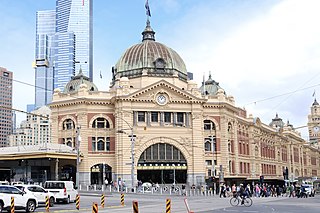
The Melbourne rail network is a passenger and freight train system in the city of Melbourne, Victoria, Australia. The metropolitan passenger rail network is centred on the Melbourne CBD and consists of 222 stations across 16 lines, which served a ridership of 99.5 million over the year 2021-2022. It is the core of the larger Victorian railway network, with links to both intrastate and interstate systems.
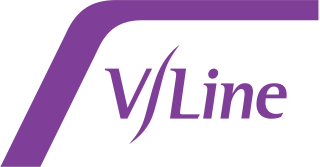
V/Line is a statutory authority that operates regional passenger train and coach services in Victoria, Australia. It provides passenger train services on five commuter lines and eight long-distance routes from its major hub at Southern Cross railway station in Melbourne. It also provides bus services across Victoria and into New South Wales, the Australian Capital Territory and South Australia. In addition, V/Line is responsible for the maintenance of much of the Victorian freight and passenger rail network outside of the areas managed by Metro Trains Melbourne and the Australian Rail Track Corporation.
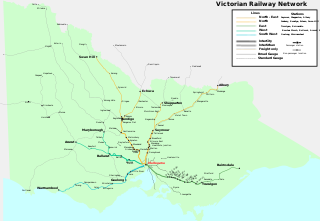
Rail transport in the Australian state of Victoria is provided by a number of railway operators who operate over the government-owned railway lines. The network consists of 2,357 km of Victorian broad gauge lines, and 1,912 km of standard gauge freight and interstate lines; the latter increasing with gauge conversion of the former. Historically, a few experimental 762 mm gauge lines were built, along with various private logging, mining and industrial railways. The rail network radiates from the state capital, Melbourne, with main interstate links to Sydney and to Adelaide, as well as major lines running to regional centres, upgraded as part of the Regional Fast Rail project.
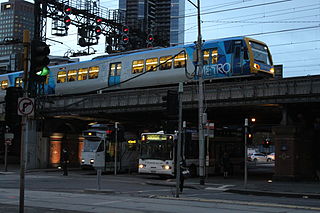
Transport in Melbourne, the state capital of Victoria, Australia, consists of several interlinking modes. Melbourne is a hub for intercity, intracity and regional travel. Road-based transport accounts for most trips across many parts of the city, facilitated by Australia's largest freeway network. Public transport, including the world's largest tram network, trains and buses, also forms a key part of the transport system. Other dominant modes include walking, cycling and commercial-passenger vehicle services such as taxis.
The South Gippsland railway line is a partially closed railway line in Victoria, Australia. It was first opened in 1892, branching from the Orbost line at Dandenong, and extending to Port Albert. Much of it remained open until December 1994. Today, only the section between Dandenong and Cranbourne remains open for use. The section of the line from Nyora to Leongatha was used by the South Gippsland Tourist Railway until it ceased operations in 2016. The section from Nyora to Welshpool, with extension trail to Port Welshpool and a portion of the former line at Koo Wee Rup, have been converted into the Great Southern Rail Trail.
Clyde was a railway station on the South Gippsland line in South Gippsland, Victoria, Australia, the station operated until the closure of the line between Cranbourne Station and Leongatha Station in 1993. All that remains of this station now is the platform mound, however the track is still in reasonable condition.
Tooradin was a railway station on the South Gippsland line in South Gippsland, Victoria, Australia, the station operated until the closure of the line between Cranbourne Station and Leongatha Station in July 1993 although the railway continued to carry freight traffic to Koala Siding near Lang Lang until January 1998.
Lang Lang was a railway station on the South Gippsland line in South Gippsland, Victoria, Australia. The station operated until the closure of the line between Cranbourne Station and Leongatha Station in 1993. This station remains partially intact with its platform and signals still in reasonable condition, the track along this section is still in reasonable condition.

Leongatha is a railway station in the town of Leongatha, Victoria on the former South Gippsland railway line in South Gippsland, Victoria, Australia.
The Mildura railway line is a heavy rail line in northwestern Victoria, Australia. The line runs from Yelta station to Ballarat station via the settlements of Mildura, Ouyen and Maryborough in an approximate south-southeasterly direction. Initial sections of the line opened from Ballarat in 1874 and the line reached Mildura in 1903.
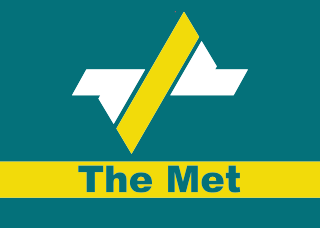
The Public Transport Corporation (PTC) was a Victoria State Government owned statutory authority formed under the Transport Act 1983 which operated passenger and freight trains, trams and bus services.

The Doncaster railway line was a long-proposed suburban railway in the eastern suburbs of Melbourne, Victoria, Australia, that was anticipated to be built before December 2027, as a branch, along with the Hurstbridge line, of the planned future Clifton Hill Loop Line, as part of the 2013 PTV Network Development Plan.
The East West Link was a proposed 18-kilometre tollway in Melbourne, Australia, to connect the Eastern Freeway at Clifton Hill with the Western Ring Road at Sunshine West. The Napthine Coalition Government signed a $5.3 billion contract with the East West Connect consortium in September 2014, just prior to the November 2014 state election, to begin construction on the eastern tunnel segment of the project. It became one of the central issues in the election, and a subsequent change in government led to the project's cancellation at a cost of $1.1 billion. The problem of poor "connectivity between Melbourne's Eastern Freeway and CityLink" has since been included in Infrastructure Australia's list of Australia's 32 "highest priority" infrastructure needs and various solutions remain part of long-term state road planning.
The New Deal for Country Passengers was a timetable introduced on 4 October 1981 in Victoria, Australia which revolutionised the provision of country passenger railway services. Thirty-five little-used passenger stations were closed, rolling stock utilisation was improved, and new rolling stock introduced. The timetable and associated service changes resulted in an average patronage growth of 8.7% per year, from 3 million in 1981 to 5.6 million passengers in 1990/91.

The 1969 Melbourne Transportation Plan was a road and rail transport plan for Melbourne, the state capital of Victoria, Australia, instituted by Henry Bolte's state government. Most prominently, the plan recommended the provision of an extensive freeway network, much of which has since been built.
The Eddington Transport Report was a major transport study undertaken in Victoria, Australia, by infrastructure consultant Sir Rod Eddington to propose improvements to transport links between the eastern and western suburbs of Melbourne. The report, titled "Investing in Transport–East West Link Needs Assessment", was commissioned in 2006 by the Government of Victoria following the model of the Eddington Transport Study in the United Kingdom and was released in April 2008. Eddington's report recommended new road and rail tunnels, further rail network electrification and improved cycle and bus routes in a bid to reduce congestion. Some of the report's recommendations were implemented by the Brumby Labor government, but many others remain unfunded.
The Cobram railway line was a short branch of the Tocumwal line in the north-eastern region of the Victorian railway network.









